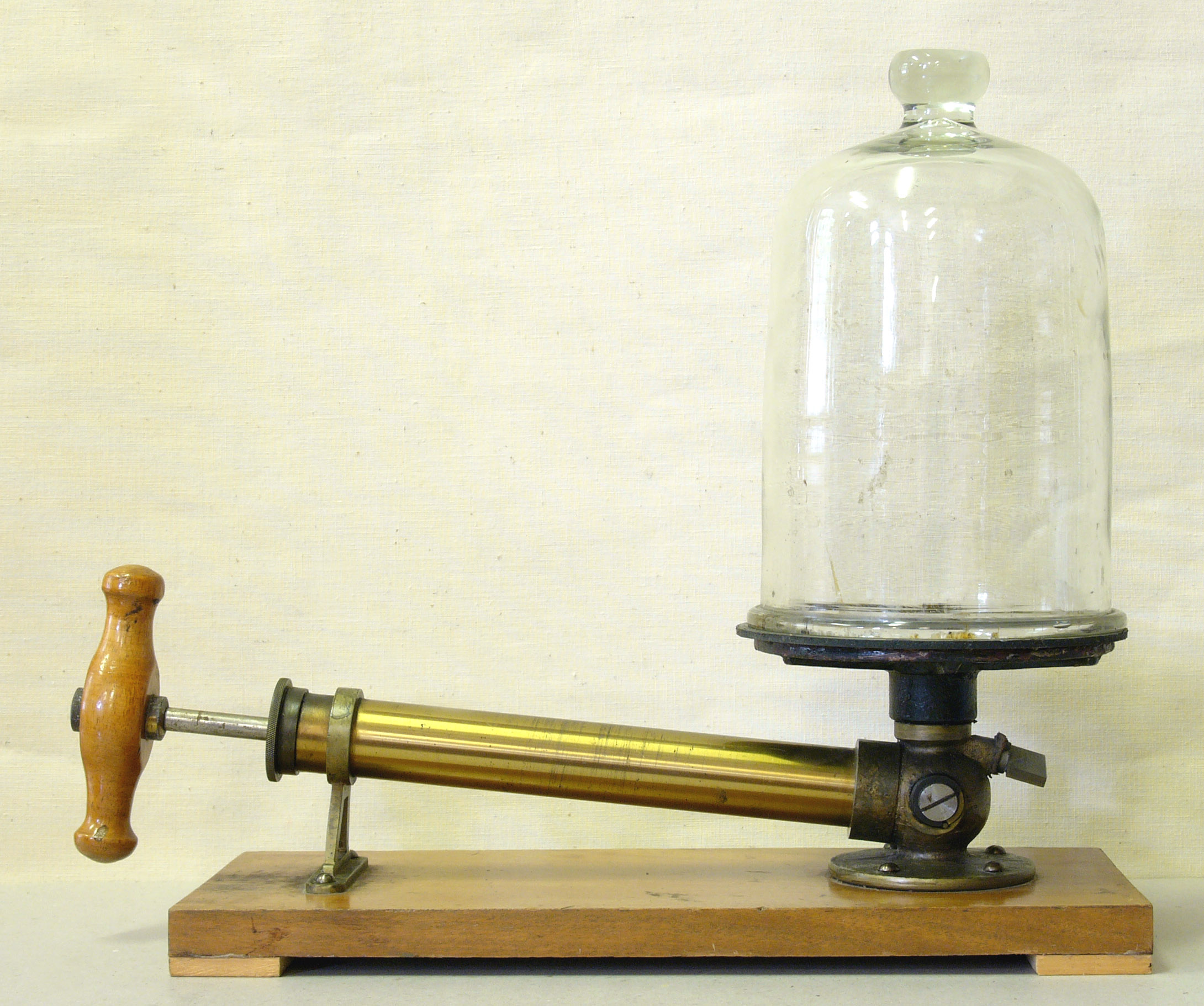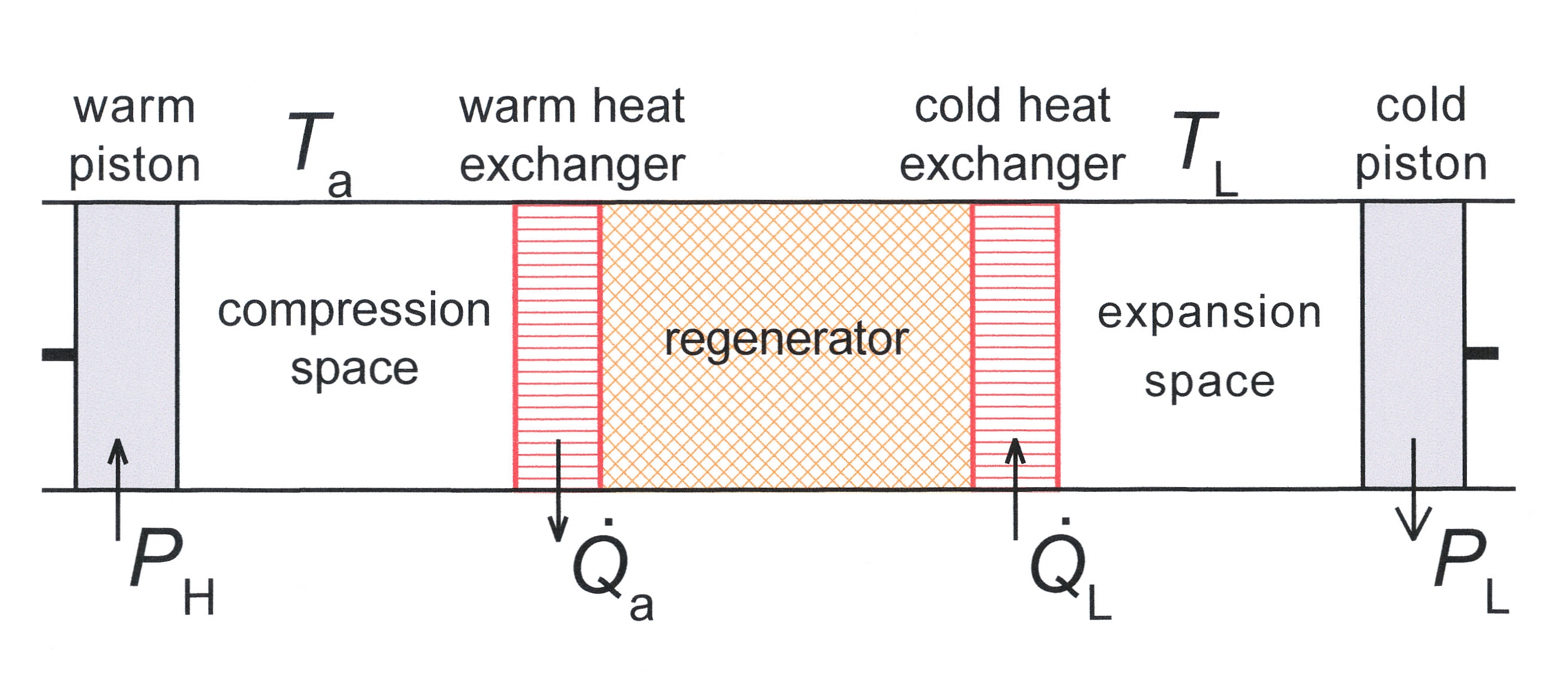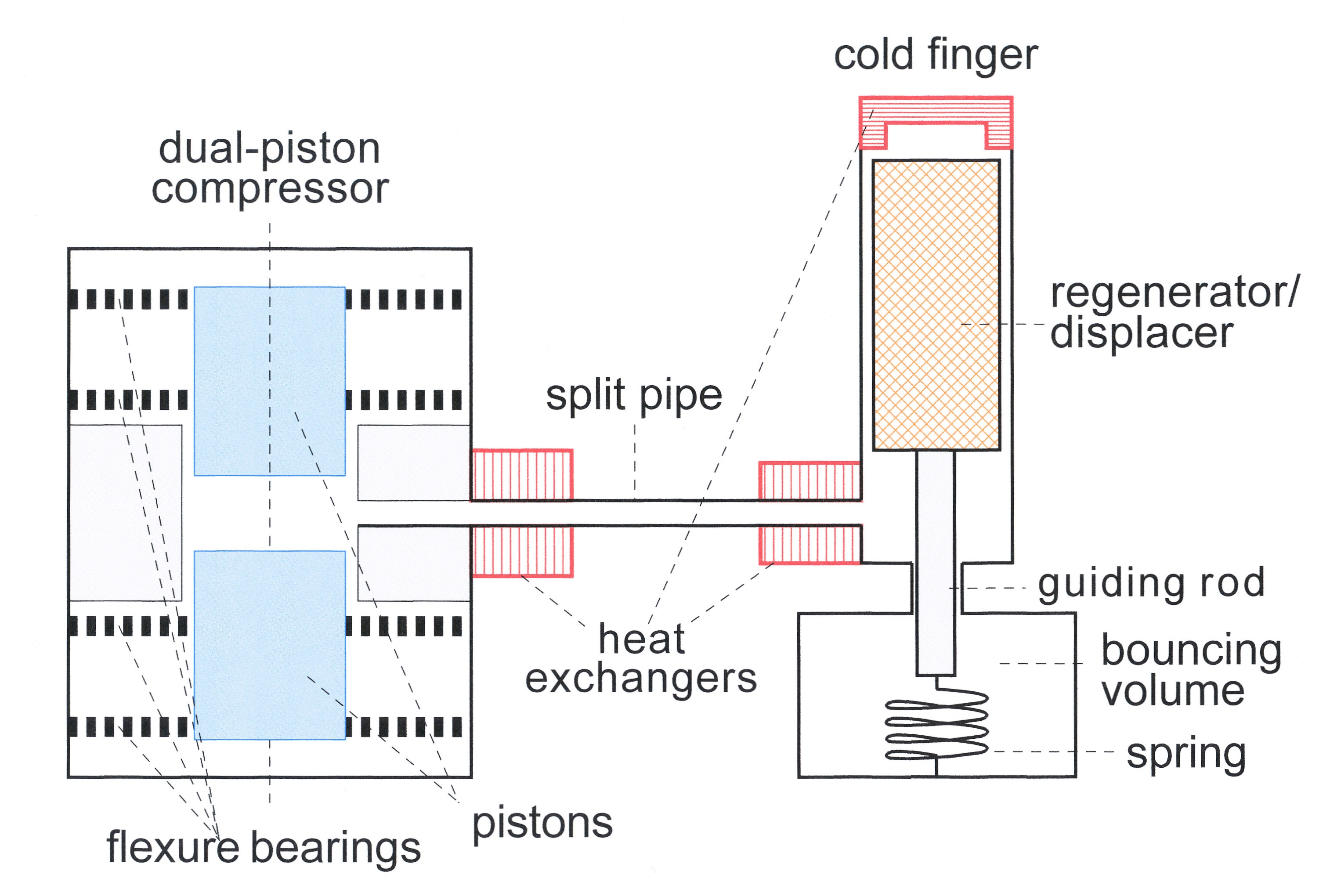|
Cryopump
A cryopump or a "cryogenic pump" is a vacuum pump that traps gases and vapours by condensing them on a cold surface, but are only effective on some gases. The effectiveness depends on the freezing and boiling points of the gas relative to the cryopump's temperature. They are sometimes used to block particular contaminants, for example in front of a diffusion pump to trap backstreaming oil, or in front of a McLeod gauge to keep out water. In this function, they are called a cryotrap, waterpump or cold trap, even though the physical mechanism is the same as for a cryopump. Cryotrapping can also refer to a somewhat different effect, where molecules will increase their residence time on a cold surface without actually freezing (supercooling). There is a delay between the molecule impinging on the surface and rebounding from it. Kinetic energy will have been lost as the molecules slow down. For example, hydrogen does not condense at 8 kelvins, but it can be cryotrapped. This effective ... [...More Info...] [...Related Items...] OR: [Wikipedia] [Google] [Baidu] |
Vacuum Pump
A vacuum pump is a type of pump device that draws gas particles from a sealed volume in order to leave behind a partial vacuum. The first vacuum pump was invented in 1650 by Otto von Guericke, and was preceded by the suction pump, which dates to antiquity. History Early pumps The predecessor to the vacuum pump was the suction pump. Dual-action suction pumps were found in the city of Pompeii. Arabic engineer Al-Jazari later described dual-action suction pumps as part of water-raising machines in the 13th century. He also said that a suction pump was used in siphons to discharge Greek fire. The suction pump later appeared in medieval Europe from the 15th century. Donald Routledge Hill (1996), ''A History of Engineering in Classical and Medieval Times'', Routledge, pp. 143 & 150-2 Donald Routledge Hill, "Mechanical Engineering in the Medieval Near East", ''Scientific American'', May 1991, pp. 64-69 (cf. Donald Routledge HillMechanical Engineering By the 17th century, water ... [...More Info...] [...Related Items...] OR: [Wikipedia] [Google] [Baidu] |
Diffusion Pump
Diffusion pumps use a high speed jet of vapor to direct gas molecules in the pump throat down into the bottom of the pump and out the exhaust. They were the first type of high vacuum pumps operating in the regime of free molecular flow, where the movement of the gas molecules can be better understood as diffusion than by conventional fluid dynamics. Invented in 1915 by Wolfgang Gaede, he named it a ''diffusion pump'' since his design was based on the finding that gas cannot diffuse against the vapor stream, but will be carried with it to the exhaust. However, the principle of operation might be more precisely described as gas-jet pump, since diffusion also plays a role in other types of high vacuum pumps. In modern textbooks, the diffusion pump is categorized as a vacuum pump#Momentum transfer, momentum transfer pump. The diffusion pump is widely used in both industrial and research applications. Most modern diffusion pumps use silicone oil or polyphenyl ethers as the working flui ... [...More Info...] [...Related Items...] OR: [Wikipedia] [Google] [Baidu] |
Vacuum Pumps
A vacuum (: vacuums or vacua) is space devoid of matter. The word is derived from the Latin adjective (neuter ) meaning "vacant" or "void". An approximation to such vacuum is a region with a gaseous pressure much less than atmospheric pressure. Physicists often discuss ideal test results that would occur in a ''perfect'' vacuum, which they sometimes simply call "vacuum" or free space, and use the term partial vacuum to refer to an actual imperfect vacuum as one might have in a laboratory or in space. In engineering and applied physics on the other hand, vacuum refers to any space in which the pressure is considerably lower than atmospheric pressure. The Latin term ''in vacuo'' is used to describe an object that is surrounded by a vacuum. The ''quality'' of a partial vacuum refers to how closely it approaches a perfect vacuum. Other things equal, lower gas pressure means higher-quality vacuum. For example, a typical vacuum cleaner produces enough suction to reduce air pressur ... [...More Info...] [...Related Items...] OR: [Wikipedia] [Google] [Baidu] |
Cryocooler
A cryocooler is a refrigerator designed to reach cryogenic temperatures (below 120 K, -153 °C, -243.4 °F). The term is most often used for smaller systems, typically table-top size, with input powers less than about 20 kW. Some can have input powers as low as 2–3 W. Large systems, such as those used for cooling the superconducting magnets in particle accelerators are more often called cryogenic refrigerators. Their input powers can be as high as 1 MW. In most cases cryocoolers use a cryogenic fluid as the working substance and employ moving parts to cycle the fluid around a thermodynamic cycle. The fluid is typically compressed at room temperature, precooled in a heat exchanger, then expanded at some low temperature. The returning low-pressure fluid passes through the heat exchanger to precool the high-pressure fluid before entering the compressor intake. The cycle is then repeated. __TOC__ Ideal heat exchangers and regenerators Heat exchangers are important componen ... [...More Info...] [...Related Items...] OR: [Wikipedia] [Google] [Baidu] |
Zeolite
Zeolites are a group of several microporous, crystalline aluminosilicate minerals commonly used as commercial adsorbents and catalysts. They mainly consist of silicon, aluminium, oxygen, and have the general formula ・y where is either a metal ion or H+. The term was originally coined in 1756 by Swedish mineralogist Axel Fredrik Cronstedt, who observed that rapidly heating a material, believed to have been stilbite, produced large amounts of steam from water that had been adsorbed by the material. Based on this, he called the material ''zeolite'', from the Greek , meaning "to boil" and , meaning "stone". Zeolites occur naturally, but are also produced industrially on a large scale. , 253 unique zeolite frameworks have been identified, and over 40 naturally occurring zeolite frameworks are known. Every new zeolite structure that is obtained is examined by the International Zeolite Association Structure Commission (IZA-SC) and receives a three-letter designation. Character ... [...More Info...] [...Related Items...] OR: [Wikipedia] [Google] [Baidu] |
Cryocooler
A cryocooler is a refrigerator designed to reach cryogenic temperatures (below 120 K, -153 °C, -243.4 °F). The term is most often used for smaller systems, typically table-top size, with input powers less than about 20 kW. Some can have input powers as low as 2–3 W. Large systems, such as those used for cooling the superconducting magnets in particle accelerators are more often called cryogenic refrigerators. Their input powers can be as high as 1 MW. In most cases cryocoolers use a cryogenic fluid as the working substance and employ moving parts to cycle the fluid around a thermodynamic cycle. The fluid is typically compressed at room temperature, precooled in a heat exchanger, then expanded at some low temperature. The returning low-pressure fluid passes through the heat exchanger to precool the high-pressure fluid before entering the compressor intake. The cycle is then repeated. __TOC__ Ideal heat exchangers and regenerators Heat exchangers are important componen ... [...More Info...] [...Related Items...] OR: [Wikipedia] [Google] [Baidu] |
Torr
The torr (symbol: Torr) is a Pressure#Units, unit of pressure based on an absolute scale, defined as exactly of a standard atmosphere (unit), atmosphere (101325 Pa). Thus one torr is exactly (≈ ). Historically, one torr was intended to be the same as one "millimetre of mercury", but subsequent redefinitions of the two units of measurement, units made the torr marginally lower (by less than 0.000015%). The torr is not part of the International System of Units (SI). Even so, it is often combined with the metric prefix milli to name one millitorr (mTorr), equal to 0.001 Torr. The unit was named after Evangelista Torricelli, an Italian physicist and mathematician who discovered the principle of the barometer in 1644. Nomenclature and common errors The unit name ''torr'' is written in letter case, lower case, while its symbol ("Torr") is always written with an uppercase initial; including in combinations with prefixes and other unit symbols, as in "mTorr" (millitorr) or " ... [...More Info...] [...Related Items...] OR: [Wikipedia] [Google] [Baidu] |
Procedures In Experimental Physics
Procedure may refer to: * Medical procedure * Instructions or recipes, a set of commands that show how to achieve some result, such as to prepare or make something * Procedure (business), specifying parts of a business process * Standard operating procedure, a step-by-step instruction to achieve some result, used in industry and military * Legal procedure, the body of law and rules used in the administration of justice in the court system, including: ** Civil procedure ** Criminal procedure ** Administrative procedure * Parliamentary procedure, a set of rules governing meetings * Procedure (computer science), also termed a subroutine, function, or subprogram ** Stored procedure A stored procedure (also termed prc, proc, storp, sproc, StoPro, StoredProc, StoreProc, sp, or SP) is a subroutine available to applications that access a relational database management system (RDBMS). Such procedures are stored in the database d ..., a subroutine in the data dictionary of a relational ... [...More Info...] [...Related Items...] OR: [Wikipedia] [Google] [Baidu] |
Rita G
Rita may refer to: People * Rita (given name) * Rita (Indian singer) (born 1984) * Rita (Israeli singer) (born 1962) * Rita (Japanese singer) * Eliza Humphreys (1850–1938), wrote under the pseudonym Rita Places * Djarrit, also known as Rita, a community in the Marshall Islands * 1180 Rita, an asteroid * Rita, West Virginia * Santa Rita, California (other), several places Film, television, and theater * ''Rita'' (1959 film), an Australian television play * ''Rita'' (2009 Italian film), an Italian film * ''Rita'' (2009 Indian film), a Marathi film directed by Renuka Shahane * ''Rita'' (2024 Guatemalan film), Guatemalan dark fantasy film * ''Rita'' (2024 Spanish film), an upcoming Spanish drama film * ''Rita'' (TV series), a Danish television show * RITA Award, an award for romantic fiction * '' Educating Rita'', a 1980 stage play by Willy Russel ** ''Educating Rita'' (film), a 1983 British film based on that play *Rita Oberoi, fictional character in the 19 ... [...More Info...] [...Related Items...] OR: [Wikipedia] [Google] [Baidu] |
Pascal (unit)
The pascal (symbol: Pa) is the unit of pressure in the International System of Units (SI). It is also used to quantify internal pressure, stress, Young's modulus, and ultimate tensile strength. The unit, named after Blaise Pascal, is an SI coherent derived unit defined as one newton per square metre (N/m2). It is also equivalent to 10 barye (10 Ba) in the CGS system. Common multiple units of the pascal are the hectopascal (1 hPa = 100 Pa), which is equal to one millibar, and the kilopascal (1 kPa = 1000 Pa), which is equal to one centibar. The unit of measurement called '' standard atmosphere (atm)'' is defined as . Meteorological observations typically report atmospheric pressure in hectopascals per the recommendation of the World Meteorological Organization, thus a standard atmosphere (atm) or typical sea-level air pressure is about 1013 hPa. Reports in the United States typically use inches of mercury or millibars (hectopascals). In Cana ... [...More Info...] [...Related Items...] OR: [Wikipedia] [Google] [Baidu] |
Outgassing
Outgassing (sometimes called offgassing, particularly when in reference to indoor air quality) is the release of a gas that was dissolved, trapped, frozen, or absorbed in some material. Outgassing can include sublimation and evaporation (which are phase transitions of a substance into a gas), as well as desorption, seepage from cracks or internal volumes, and gaseous products of slow chemical reactions. Boiling is generally thought of as a separate phenomenon from outgassing because it consists of a phase transition of a liquid into a vapor of the same substance. In a vacuum Outgassing is a challenge to creating and maintaining clean high- vacuum environments. NASA and ESA maintain lists of materials with low-outgassing properties suitable for use in spacecraft, as outgassing products can condense onto optical elements, thermal radiators, or solar cells and obscure them. Materials not normally considered absorbent can release enough lightweight molecules to interfere wi ... [...More Info...] [...Related Items...] OR: [Wikipedia] [Google] [Baidu] |




